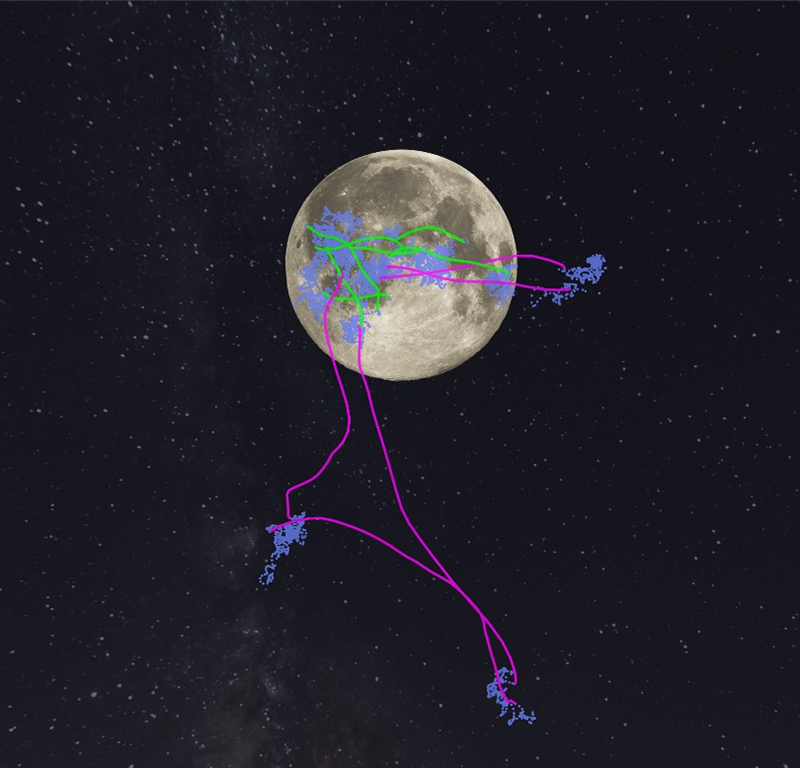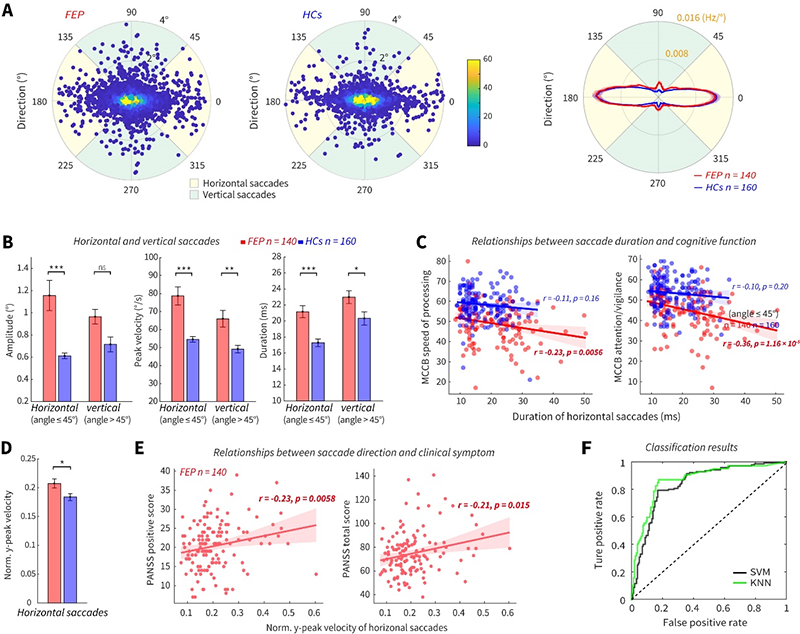A recent study published in Schizophrenia Bulletin demonstrated spatial and temporal abnormalities of spontaneous fixational saccades and their correlates with positive and cognitive symptoms in schizophrenia. This work was performed by researchers in Dr. WANG Wei’s lab at the Center for Excellence in Brain Science and Intelligence Technology of the Chinese Academy of Sciences and Dr. WANG Jijun’ team at Shanghai Mental Health Center, Shanghai Jiao Tong University School of Medicine. This work suggests fixational saccades are a promising and easily obtainable biomarker for cognitive and positive symptoms and for complementary diagnosis in schizophrenia.
Schizophrenia is a devastating heterogenous psychotic disorder characterized by debilitating positive symptoms, negative symptoms, and cognitive deficits. Positive symptoms include hallucinations, delusions, disorganized speech and bizarre behaviors. Negative symptoms constitute an absence of normal functioning, such as affective flattening, anhedonia, poverty of speech, and social withdrawal. Cognitive deficits are observed in the majority of people with schizophrenia, involving many cognitive domains such as attention and working memory. These manifestations of schizophrenia are associated with altered neurotransmitter systems giving rise to structural and functional abnormalities of the cortical-subcortical-cerebellar circuit.
Given the central importance of seeing to humans, visual fixation is a fundamental behavioral pattern that allows us to gather information and guide decision-making. During visual fixation, microsaccades and large saccades (macrosaccades) occur spontaneously and frequently (Figure 1). These fixational saccades are sensitive to the structural and functional alterations of the cortical-subcortical-cerebellar circuit, and are closely linked with cognitive processes. However, the performances of fixational saccades in patients with schizophrenia remain largely unexplored.

Figure 1. When we stare at the moon, our eyes are not still but exhibit fixational saccades including microsaccades and macrosaccades. Microsaccades (green lines) with amplitudes typically less than 1° contribute to maintaining visibility by refreshing retinal images to prevent visual fading. Macrosaccades (magenta lines) can be considered saccadic intrusions that interrupt fixation.
Researchers analyzed fixational saccades recorded from 140 drug-na?ve patients with first-episode schizophrenia and 160 age-matched healthy subjects during ten separate six-second attempted fixations. They found that patients with schizophrenia exhibited significantly more vertical saccades and a greater vertical deviation of horizontal saccades (Figure 2A right and 2D). They also found that the fixational saccades, especially horizontal saccades, had longer durations, faster peak velocities, and larger amplitudes in patients than in controls (Figure 2B).
Through careful measurements of the schizophrenia patient’s cognitive capacities, they showed that the longer duration of horizontal saccades was associated with lower cognitive performance, especially deficits in attention/vigilance and speed of processing (Figure 2C). In addition, the greater vertical deviation of horizontal saccades was associated with more severe positive symptoms (Figure 2E). Finally, based solely on the fixational eye movements recorded during a one-minute period, a simple machine-learning model classified patients and controls with an accuracy of 85% (Figure 2F). These findings demonstrate that fixational saccades are a promising and easily obtainable biomarker for cognitive and positive symptoms and for complementary diagnosis in schizophrenia.

Figure 2. (A) The spatial distribution of fixational saccades for patients with first-episode schizophrenia (FEP) and healthy controls (HCs). (B) Comparison of the amplitude, peak velocity and duration of horizontal and vertical saccades between patients and controls. (C) Relationships between fixational saccade duration and cognition. (D) Patients exhibited fixational saccades more vertically. (E) Relationships between fixational saccade direction and clinical symptoms. (F) Receiver operating characteristic (ROC) curves for SVM and KNN algorithms.
The study entitled “Spatial and temporal abnormalities of spontaneous fixational saccades and their correlates with positive and cognitive symptoms in schizophrenia” was published as a research article online in Schizophrenia Bulletin on April 17, 2023. This work was mainly conducted by Dr. LIU Xu of Shanghai Mental Health Center, Shanghai Jiao Tong University School of Medicine under the supervision of Dr. WANG Wei at the Center for Excellence in Brain Science and Intelligence Technology of the Chinese Academy of Sciences and Dr. WANG Jijun at Shanghai Mental Health Center, Shanghai Jiaotong University School of Medicine. Collaborators included Dr. Ian Max ANDOLINA at the Center for Excellence in Brain Science and Intelligence Technology of the Chinese Academy of Sciences, Dr. Lothar SPILLMANN of the University of Freiburg, and Dr. Niall McLoughlin of the School of Optometry and Vision Science at the University of Bradford. This research was supported by the Chinese Academy of Sciences, Clinical Research Center at Shanghai Mental Health Center, Shanghai Municipality, National Natural Science Foundation of China and Chinese Ministry of Education.
Link: https://doi.org/10.1093/schbul/sbad039
Keywords: schizophrenia, visual fixation, microsaccades and macrosaccades, biomarker, classification
AUTHOR CONTACT:
WANG Wei or WANG Jijun
Center for Excellence in Brain Science and Intelligence Technology of the Chinese Academy of Sciences, Shanghai, China.
E-mail: w.wang@ion.ac.cn or jijunwang27@163.com

